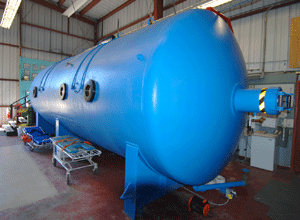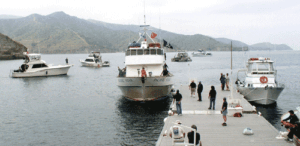The operation and funding of the USC Catalina Hyperbaric Chamber is truly unique compared to the rest of the hyperbaric chambers in the United States:
- The Catalina Hyperbaric Chamber is only used for diving accidents. Most other medical hyperbaric chambers in this country are used for other hyperbaric therapies and treatments such as wound healing, burns, carbon monoxide poisoning, and other clinical applications. These clinical treatments are the bread and butter for most chambers since diving accidents are sporadic and, luckily, not that common.
- The Catalina Hyperbaric Chamber is staffed by a crew of volunteers. There are only two Chamber Crew members who are paid, a full time Director and a part time Chamber Technician. The Chamber Crew consists of approximately 80 volunteers who come from all walks of life and donate their time and energies to be on-call at the Chamber.
These two factors result in a Chamber operation that does not have many personnel costs in its operation and at the same time, if the Chamber were to depend upon income from treating divers, operational funds would be tenuous at best. How then is the Catalina Hyperbaric Chamber funded, and able to be available 24 hours-a-day, 365 days-a-year to treat diving emergencies from the recreational, fisheries, research, public safety, and military diving communities?
 The USC Catalina Hyperbaric Chamber is set up as an extension of the Los Angeles County/USC Medical Center – Department of Emergency Medicine and is part of the countywide Medical Alert Center (MAC). Los Angeles County provides USC with a contract which covers about half of the annual operational costs of the Chamber. L.A. County then recoups these contract funds when the County Medical Center bills the divers who are treated at the Chamber (~$4,000 for a base treatment). In essence, the County Contract is a loan against future treatments and the Chamber itself cannot bill patients for services.
The USC Catalina Hyperbaric Chamber is set up as an extension of the Los Angeles County/USC Medical Center – Department of Emergency Medicine and is part of the countywide Medical Alert Center (MAC). Los Angeles County provides USC with a contract which covers about half of the annual operational costs of the Chamber. L.A. County then recoups these contract funds when the County Medical Center bills the divers who are treated at the Chamber (~$4,000 for a base treatment). In essence, the County Contract is a loan against future treatments and the Chamber itself cannot bill patients for services.
If the County Contract covers only half of the operational expenses, where does the rest of funding come from? The Catalina Hyperbaric Chamber depends upon the diving community for these remaining operating funds which come from other sources, such as, fund raisers, donations, promotional items, and tuition from accident management and chamber operation courses.
About $80,000 needs to be raised from these sources each year to insure the continued operation of the Catalina Hyperbaric Chamber. There are many sources of these contributions including the Avalon Harbor Underwater Clean-Up and our major fund raiser, Chamber Day & Chamber Evening. Chamber Day brings in a majority of the non-L.A. County funds for the Chamber. Chamber Day was conceived by members of the Southern California Diving Community as a way for recreational divers to have fun diving while at the same time making a financial contribution to the USC Catalina Hyperbaric Chamber. Dive-charter boats graciously donate their time and services for the day, and divers pay to dive Catalina Island aboard one of the participating boats. All of the funds raised from the event go to support the Chamber. Chamber Evening is a fund raising dinner at the Aquarium of the Pacific in Long Beach for those people unable to get away for a day of diving.
What the Chamber Program receives from USC’s Overhead Charges
The funds from the County Contract and those collected from Chamber Day and the other sources are put into the USC accounts which have, like most university accounts, an overhead. The overhead (15%) is only taken out when the money is spent, it is not taken off the top. This means a 15% overhead works out to be 13% of all the monies spent by the Chamber (including the overhead).
Some people think this seems like a lot of Chamber money going to the USC General Fund and a commonly asked question is,
“What does the Chamber Program get from USC for these overhead expenses?”
 First and foremost it gets the Chamber, which belongs to USC. In addition it receives the administrative support and benefits of belonging to USC, as well as USC’s non-profit status. For example, all the volunteers who work at the chamber are considered “employees” while they are here and are covered by USC Workman’s Comp. In terms of specifics, the following are some of the items provided by USC to the Chamber program without additional charge:
First and foremost it gets the Chamber, which belongs to USC. In addition it receives the administrative support and benefits of belonging to USC, as well as USC’s non-profit status. For example, all the volunteers who work at the chamber are considered “employees” while they are here and are covered by USC Workman’s Comp. In terms of specifics, the following are some of the items provided by USC to the Chamber program without additional charge:
- USC Main Campus Business Office support
- Housing for Volunteer Chamber Crew (Apartment + electricity + water)
- Free transportation for volunteers on School Boats
- Use of University vehicles on the island
- Office Space for Chamber Office (including electricity)
- Telephone System with no charge for USC’s local coverage calls (whereas normally any calls off island are long distance, even to the same 310 area code)
- Computer System and support
- Internet connectivity (e-mail, web server, e-mail list server, etc.)
- Chamber Hanger space
- Medical Trailer space
- Electricity for Office, Chamber Hanger, Medical Trailer, and COMPRESSORS!
- and finally, the CHAMBER!
There are a whole lot of other little things that if you add up the time and effort it would take to deal with them would be a major cost in personnel and expense.
Is all of this worth the overhead that USC receives annually from the Chamber’s accounts? ABSOLUTELY!
If the Chamber Program were to gain these overhead funds and lose the benefits listed above, it would require more money and effort to operate the Chamber Program. Not only would we have to start paying for the items and services listed above, but additional personnel would have to be hired by the Chamber Program to take on all the additional work that is now done by USC services.
In conclusion, even though at first glance it may look like the USC General Fund is just receiving funds raised for the Chamber, in reality USC is providing many services for the Chamber Program at a very reasonable rate. Therefore, all the funds raised for the Chamber, including the overhead funds sent to the USC General Fund, find their way back to benefit the Catalina Hyperbaric Chamber Program.